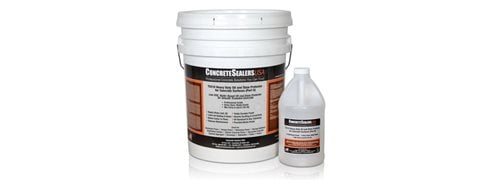- Concrete Sealer
- Comparison Chart of Concrete Sealers
- Buying Tips for Concrete Sealer Products
- Concrete Sealer Reviews: Sealer products other contractors use and recommend
- Common Questions about Concrete Sealers
- How to Remove Concrete Sealer
- Types of Sealers
- Acrylic Sealers
- Epoxy Sealers
- Penetrating Sealers
- Polyurethane Sealers
- Polyaspartic Sealers
- Application Surface
- Driveway Sealer
- Patio Sealer
- Pool Deck Sealer
- Sealers for Stamped Concrete
- Concrete Floor Sealers
- Concrete Countertop Sealers
- Pool Deck Sealer
- Exposed Aggregate Sealer
How to Choose a Concrete Sealer Gloss Level
Compare high gloss, low gloss, or matte sealer finishes and learn which is best for your concrete.Applying a sealer to new or existing concrete is one of the best things you can do to preserve the concrete’s appearance for years to come. But choosing which type of sealer to use for a particular application can be a challenge because of the wide array of sealing products available.
One of the first decisions you’ll need to make is to determine the level of shine that’s best for your concrete surface, whether it’s an interior floor or outdoor pavement. Like paint for your walls, concrete sealers come in various gloss levels, ranging from flat (matte) to a high-gloss finish that gives your concrete a wet look. Not only can the finish you choose significantly affect the appearance of your concrete, it can also impact its long-term performance.
So what are the differences between the different finishes? And what are some factors to consider when choosing one finish over another? Get answers to these and other common questions about concrete sealant gloss levels.
What is a high-gloss concrete sealer?
Generally, a high-gloss or wet-look finish is achieved by using a film-forming sealer that contains a high percentage of solids content, whether it’s an acrylic, polyurethane or epoxy (see Types of Concrete Sealers). For example, a 25% solids content usually results in a semi-gloss or satin finish while a 30% solids content will impart a high gloss. The high solids content of these sealers will result in more darkening and color enhancement of the concrete while locking out moisture, which helps preserve the decorative finish.
What is a matte concrete sealer?
Matte concrete sealers provide a natural finish with little or no gloss, resulting in a look that’s very natural. Although a matte sealer will do little to enhance the color intensity of the concrete, it will still help to protect the surface and keep out unwanted moisture. Unlike high-gloss sealers, which always form a film on the concrete surface, a matte sealer may be film-forming or penetrating, depending on the product you use.
A penetrating sealer is absorbed into the surface and is invisible after drying, so it does not change the appearance or sheen level of the concrete.
| SEALER GLOSS LEVEL | PROS | CONS | TYPICAL APPLICATIONS |
|---|---|---|---|
| Matte |
|
|
|
| High Gloss |
|
|
|
Does sealing concrete make it look better?
In addition to protecting concrete, a sealer can also enrich its color intensity (whether the color is integral or topically applied) and preserve its appearance by blocking the penetration of dirt, oil, grease, and stains. Solvent-based acrylic sealers and polyurethane sealers provide significant color enhancement and give concrete a shiny, highly reflective finish. Water-based acrylic sealers typically provide more moderate color enhancement and a satin finish.
Tip: Keep in mind that no matter what type of sealer you use, it won’t make unsightly concrete look better and it may actually magnify existing flaws. For this reason, a concrete sealer should always be applied to a clean surface free of dirt, stains, and any previous coatings.
Is matte concrete sealer better than high gloss?
The answer largely depends on your personal tastes. A sealer with a matte or low-gloss finish can be a great choice if you want to give your concrete a realistic stone-like appearance rather than a shiny, wet look. A matte finish also doesn’t show dirt, scuff marks, and wear and tear as readily as a glossy one.
If, on the other hand, you're after a mirror-like sheen that intensifies the color of the concrete and reflects light (similar to a light-reflective polished concrete floor), a high-gloss sealer will be your best choice. On the downside, glossy finishes are more slippery than their matte counterparts, which may make them unsuitable for areas with heavy foot traffic. In addition, a high-gloss concrete sealer may need to be reapplied more frequently than a matte or low-sheen sealer in order to maintain its shine.
How do you apply high-gloss concrete sealer?
Whether the sealer is high gloss or low gloss, the application steps are similar (see How to Seal Concrete in 7 Steps). First, make sure the surface you’re sealing is clean and dry so the sealer will adhere properly. Next, using a paint roller or low-pressure sprayer, apply the sealer in thin, even coats over the entire surface to avoid puddling. After application, allow the sealer to dry completely before walking or driving on the concrete.
Is a glossy concrete sealer slippery?
While it’s true that a high-gloss finish will be more slippery than a matte finish under foot or vehicle traffic, the underlying texture of the concrete also contributes to how slippery the surface may be. For example, a smooth concrete surface protected by a high-gloss film-forming sealer will be very slippery when wet, while a stamped or heavily broom-finished concrete surface with the same sealer applied will offer more traction and be less slick. If you use a low-gloss or penetrating sealer, the surface will be even less slippery.
Tip: Another option is to add an anti-skid additive directly to a film-forming sealer when it’s applied. Although these additives will help improve traction, they won’t make the surface totally skid-proof.
Does sealing concrete always make it shiny?
No. If you use a penetrating concrete sealer rather than a film-forming product there will be no change to the appearance or sheen level of the concrete surface. When you apply this type of sealer, it actually soaks into the concrete to form a barrier against moisture intrusion, deicing chemicals, and stains. Because a penetrating sealer does not leave a glossy film, it will not contribute to the slipperiness of the concrete surface. It also won’t be vulnerable to scratches and abrasion like a film-forming product.
How long does it take a sealer to dry?
It can take anywhere from 24 to 72 hours for a sealer to dry completely, depending on the product you’re using, environmental conditions (such as air temperature and humidity), the porosity of the concrete, and the thickness of sealer application. In general, solvent-based sealers dry more slowly than water-based products, since water evaporates more quickly than a solvent. Cool air temperatures and high humidity levels can also result in longer drying times.
Tip: Once a sealer is dry to the touch, you shouldn’t assume it is fully cured and ready for foot or vehicle traffic. Always follow the sealer manufacturer’s minimum dry time recommendations before opening the concrete to use.
What is the best sealer for stamped concrete?
To enrich the color of stamped concrete (which is usually provided by a topical dry-shake hardener and antiquing release), you should use a film-forming solvent- or water-based acrylic rather than a penetrating concrete sealer (see The Best Sealers for Stamped Concrete). Film-forming sealers are also the best choice for bringing out the color of exposed aggregate concrete and concrete pavers.
Be aware that some sealers may interact with certain coloring agents, resulting in unwanted side effects such as bleeding of color, haziness, and blistering. Always check with the sealer manufacturer to verify the compatibility of their product with the decorative surface you plan to put it on.
RELATED:
Concrete Driveway Sealer
Concrete Sealer FAQs
 D-One Penetrating Sealer
Non-yellowing, low sheen, good adhesion
D-One Penetrating Sealer
Non-yellowing, low sheen, good adhesion
 Deep Penetrating Sealer
RadonSeal - Waterproofs & strengthens.
Deep Penetrating Sealer
RadonSeal - Waterproofs & strengthens.
 Clear-Seal by Increte Systems
Seals and protects decorative surfaces.
Clear-Seal by Increte Systems
Seals and protects decorative surfaces.
 Heavy Duty Oil & Stain Protector
TS210 - 4 gal. kit ($439.95)
Heavy Duty Oil & Stain Protector
TS210 - 4 gal. kit ($439.95)
 Colored Concrete Sealer X-4
High gloss finish available in 20 colors
Colored Concrete Sealer X-4
High gloss finish available in 20 colors
 Gem-Guard SB
Penetrating sealer that protects against salt damage
Gem-Guard SB
Penetrating sealer that protects against salt damage
 Decorative Sealers
Reactive and penetrating formulas in various levels of gloss.
Decorative Sealers
Reactive and penetrating formulas in various levels of gloss.
 Water Repellent Penetrating
Sealer for driveways, parking structures, plazas, walkways & more.
Water Repellent Penetrating
Sealer for driveways, parking structures, plazas, walkways & more.
 Clear Acrylic Concrete Sealer
$219.30 (5 gal.)
Clear Acrylic Concrete Sealer
$219.30 (5 gal.)






